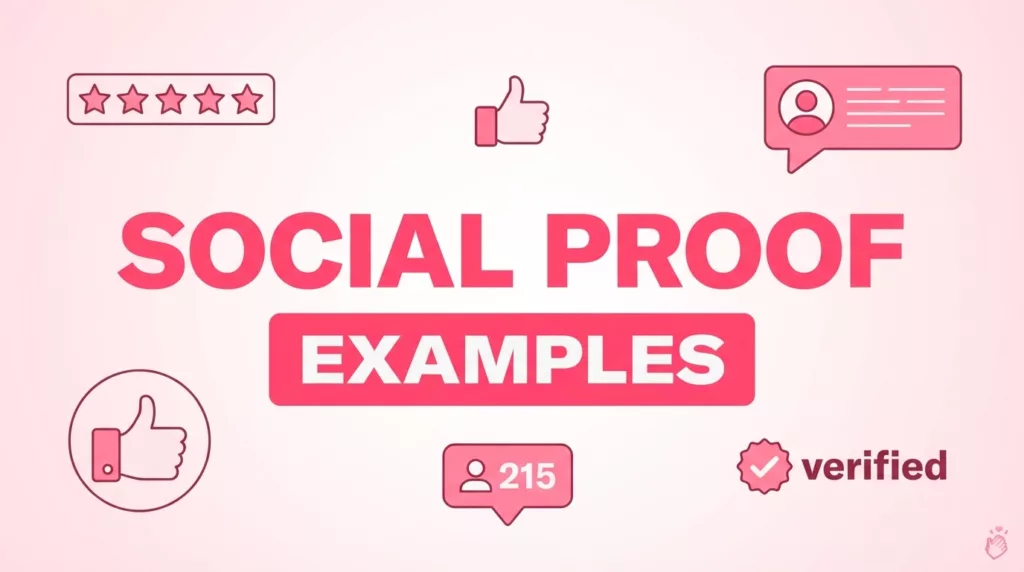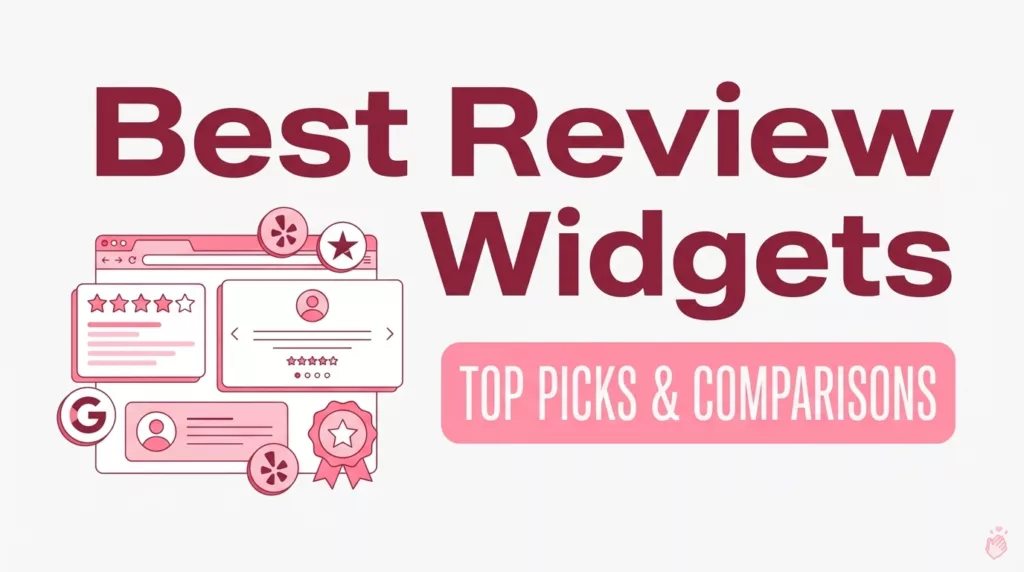
92% of B2B buyers are more likely to make a purchase after reading trusted reviews. Testimonials are one of the most effective ways to build trust, shorten sales cycles, and boost conversions in B2B marketing. For example, landing pages with testimonials can increase conversions by up to 34%.
Here’s why testimonials matter and how they work:
- Build Trust: Decision-makers rely on peer reviews to reduce risks.
- Show Results: Highlight specific metrics like “30% cost savings.”
- Ease Decisions: Address objections and simplify choices.
To use testimonials effectively:
- Collect meaningful feedback using tools like Shapo.
- Showcase testimonials with clear outcomes (e.g., “boosted sales by 15%”).
- Strategically place them across the buyer’s journey – from awareness to decision-making.
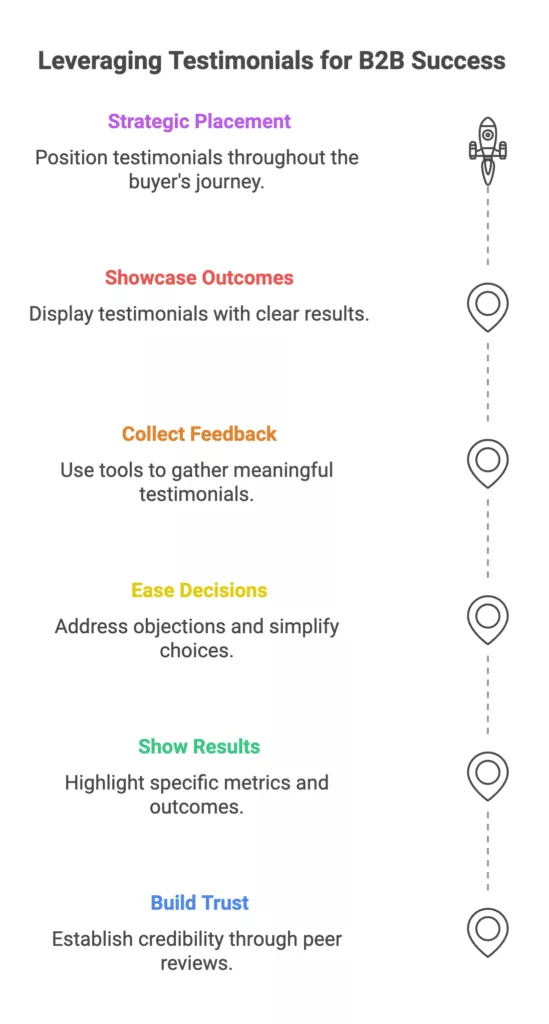
How Testimonials Affect B2B Decision-Making
Building Trust and Credibility
In the B2B world, testimonials act as trust-building tools that help buyers feel more confident in their choices. Decision-makers often look to peer experiences and recommendations to reduce the risks tied to major investments.
By sharing real-world success stories, testimonials provide social proof that’s especially meaningful in multi-stakeholder decisions. They highlight how a solution addresses specific challenges and deliver measurable results, making them relatable and persuasive for B2B buyers.
Testimonial Impact Statistics
Data shows that testimonials are highly effective at boosting conversions and shortening sales cycles. Here are some key findings:
| Metric | Impact |
|---|---|
| Conversion Rate | Landing page conversions can rise by as much as 34% with testimonials [Source] |
| Trust Factor | 88% of consumers trust online testimonials as much as personal recommendations [Source] |
These numbers underline how testimonials play a vital role in building trust within B2B relationships. They contribute to success by:
- Tackling objections upfront, simplifying the decision-making process
- Highlighting industry expertise and solution performance
Testimonials don’t just help with initial conversions – they also establish long-term credibility. This is crucial in B2B, where sales cycles are often lengthy and involve several decision-makers.
Given their proven impact, the next step is exploring how to gather and present testimonials effectively.
Collecting and Curating Effective Testimonials
Collecting Testimonials
Did you know that 92% of B2B buyers are more likely to make a purchase after reading a trusted review [Source]? That’s why gathering meaningful testimonials is a must for influencing decisions throughout the buyer journey. By focusing on testimonials that address key concerns, businesses can ease doubts, reduce perceived risks, and build trust.
Tools like Shapo and StoryPrompt make it easier to gather feedback through interactive video prompts and customizable forms. Video testimonials, in particular, stand out in B2B marketing – they’re engaging, relatable, and professional, all at the same time.
Selecting and Optimizing Testimonials
After collecting testimonials, the next step is to refine and showcase them in a way that resonates with decision-makers. The best B2B testimonials include:
| Element | Purpose | Example |
|---|---|---|
| Specific Metrics | Shows measurable results | “Reduced costs by 30%” |
| Problem-Solution | Highlights relevance and outcomes | “Automated 80% of processes” |
Organizing testimonials by industry, business challenge, or company size – like Zendesk does – helps potential customers find examples that match their needs. When refining testimonials, prioritize those with clear, quantifiable outcomes, such as “saved £50,000 annually” or “boosted sales by 15%.” These specifics make it easier for buyers to justify their decisions.
To further build trust, link testimonials to credible external sources. For example, Hello Fresh reinforces their reviews by referencing independent websites. This extra layer of verification reassures buyers during their decision-making process.
With a well-organized library of testimonials, businesses can strategically use them across marketing materials to drive engagement and increase conversions.
Using Testimonials in B2B Marketing
Testimonials Throughout the Customer Journey
Placing testimonials strategically during different stages of the buyer’s journey can influence decisions and help prospects move forward. By addressing concerns at the right moments, testimonials guide potential customers through the decision-making process.
Here’s a simple breakdown of where to use testimonials:
| Journey Stage | Focus and Placement |
|---|---|
| Awareness | Highlight challenges and solutions (blog posts, social media) |
| Consideration | Compare options (product pages, emails) |
| Decision | Showcase success stories (case studies, proposals) |
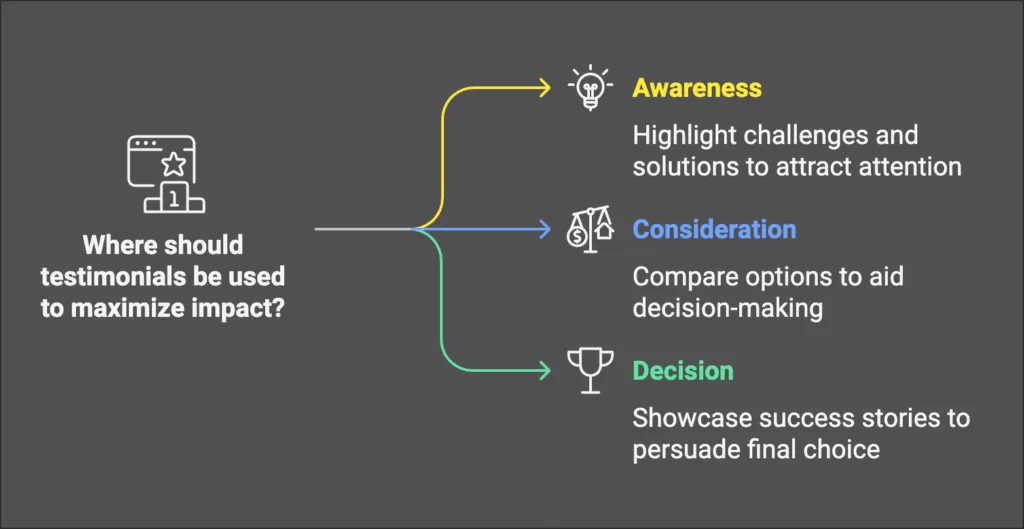
Grove Collaborative saw a 25% boost in conversion rates by placing testimonials at critical points, giving prospects the confidence to make decisions. This approach ensures testimonials tackle objections and build trust at every step.
Once testimonials are positioned effectively, the next task is integrating them into your marketing materials for maximum impact.
Incorporating Testimonials in Marketing Materials
B2B buyers want proof that your solution works, no matter the platform. After aligning testimonials with the buyer’s journey, the goal is to weave them into your marketing assets seamlessly.
Video testimonials, in particular, are becoming a must-have in B2B marketing. Shapo users have reported higher engagement when using video testimonials. Videos bring customer stories to life in ways that plain text simply can’t.
Here’s how to make the most of your testimonials:
- Website and Email: Place testimonials near pricing details, feature lists, or in nurture emails to address specific concerns.
- Sales and Demos: Use targeted testimonials that highlight measurable results, such as “30% cost savings” or “2-week implementation timelines.”
Tools like Shapo make it easier to showcase testimonials through widgets or curated testimonial pages. By using a structured approach, you can provide consistent social proof across the buyer’s journey, enhancing credibility at every touchpoint.
Tools and Methods for Managing Testimonials
Testimonial Management Platforms
Managing testimonials effectively requires the right tools. Several platforms are designed to help marketers collect, organize, and showcase customer feedback with ease. Here’s a quick look at some popular options:
| Platform | Key Features | Best For |
|---|---|---|
| StoryPrompt | AI-driven branding, video prompts | Video-focused campaigns |
| Testimonial.to | Simple collection tools | Quick setup and use |
| Boast | Video management, analytics | Enterprise-level testimonials |
| Shapo | Multi-platform integration | Multi-channel testimonials |
Displaying Testimonials Effectively
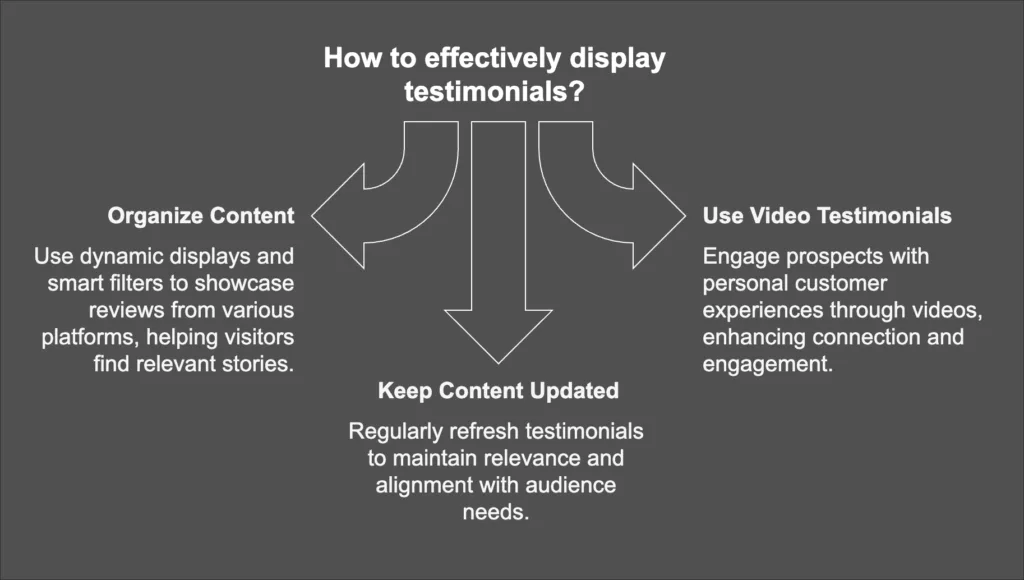
How you present testimonials can make all the difference. For example, Bizzabo uses success metrics alongside customer stories to provide clear, impactful proof that resonates with potential clients [Source].
To make the most of your testimonials, try these strategies:
- Organize and Filter Content: Use dynamic displays that pull reviews from various platforms. Smart filters can help visitors quickly find stories that match their interests or industry.
- Use Video Testimonials: Videos create a deeper connection with prospects. They’re engaging and allow customers to share their experiences in a more personal way. Platforms like Shapo can simplify video collection while keeping your branding consistent.
- Keep Content Updated: Regularly refresh your testimonials to ensure they stay relevant and aligned with your audience’s current challenges and goals.
When paired with the right tools and thoughtful strategies, testimonials can strengthen trust and reinforce your brand at every stage of the customer journey.
Related video from YouTube
Conclusion: The Importance of Testimonials in B2B Marketing
Testimonials play a key role in B2B marketing. With 92% of buyers more likely to make a purchase after reading trusted reviews, they provide real customer insights that resonate with decision-makers. They can also increase landing page conversions by up to 34%, making a noticeable difference in business outcomes [Source].

Zendesk offers a great example by organizing testimonials based on industry and challenges, ensuring relevance and impact [Source]. While conversion rates are important, the real strength of testimonials lies in the trust they build – 85% of customers trust reviews as much as personal recommendations.
Tools designed for managing testimonials make it easier to gather, organize, and share customer stories. By focusing on thoughtful collection, careful presentation, and strategic placement, B2B marketers can see measurable results. With 97% of B2B buyers trusting user-generated content more than other types, testimonials remain a powerful way to drive growth and build stronger customer relationships.

